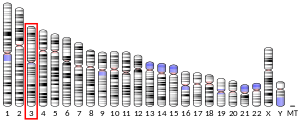Neutral cholesterol ester hydrolase 1
Neutral cholesterol ester hydrolase 1 (NCEH) also known as arylacetamide deacetylase-like 1 (AADACL1) or KIAA1363 is an enzyme that in humans is encoded by the NCEH1 gene.[5]
NCEH is an enzyme located in the endoplasmic reticulum. NCEH hydrolyzes 2-acetyl monoalkylglycerol ether, as part of an enzymatic pathway regulating the levels of platelet activating factor and lysophospholipids that may be involved in cancer development.[6][7]
Function
The enzymatic reaction catalyzed by NCEH is:[6]
- 2-acetyl monoalkylglycerol ether → monoalkylglycerol ether
Monoalkylglycerol ethers (MAGEs) can then be converted to lysophospholipids alkyl-lysophosphatidic acid (alkyl-LPA) and alkyl-lysophosphatidylcholine (alkyl-LPC).
Controversial studies by one group also implicate the protein in the hydrolysis of cholesterol esters.[8] However, loss of the protein in mice selectively reduces 2-acetyl monoalkylglycerol ether activity throughout the body.[7]
Clinical significance
Evidence suggests a role for NCEH in cancer. Cancer cell lines contain unusually high levels of the protein.[9] Reduction of the amount of NCEH1 in cancer cells reduces tumor migration and growth in mice and addition of alkyl-LPA restores these processes.[6]
NCEH can break down organophosphates like the pesticide metabolite chlorpyrifos oxon.[10] Conversely, enzymatic activity can be inhibited by organophosphates.[11]
Structure
NCEH is a serine hydrolase that contains an N-terminal transmembrane domain, a central catalytic domain and a lipid-binding domain at its C-terminus.[12] The protein exists in three isoforms that result from differences in mRNA splicing. Transcripts encode a protein for isoform a of 448, b of 440 and c of 275 amino acids long.
References
- GRCh38: Ensembl release 89: ENSG00000144959 - Ensembl, May 2017
- GRCm38: Ensembl release 89: ENSMUSG00000027698 - Ensembl, May 2017
- "Human PubMed Reference:". National Center for Biotechnology Information, U.S. National Library of Medicine.
- "Mouse PubMed Reference:". National Center for Biotechnology Information, U.S. National Library of Medicine.
- "Entrez Gene: Neutral cholesterol ester hydrolase 1".
- Chiang KP, Niessen S, Saghatelian A, Cravatt BF (Oct 2006). "An enzyme that regulates ether lipid signaling pathways in cancer annotated by multidimensional profiling". Chemistry & Biology. 13 (10): 1041–50. doi:10.1016/j.chembiol.2006.08.008. PMID 17052608.
- Buchebner M, Pfeifer T, Rathke N, Chandak PG, Lass A, Schreiber R, Kratzer A, Zimmermann R, Sattler W, Koefeler H, Fröhlich E, Kostner GM, Birner-Gruenberger R, Chiang KP, Haemmerle G, Zechner R, Levak-Frank S, Cravatt B, Kratky D (Oct 2010). "Cholesteryl ester hydrolase activity is abolished in HSL-/- macrophages but unchanged in macrophages lacking KIAA1363". Journal of Lipid Research. 51 (10): 2896–908. doi:10.1194/jlr.M004259. PMC 2936755. PMID 20625037.
- Igarashi M, Osuga J, Uozaki H, Sekiya M, Nagashima S, Takahashi M, Takase S, Takanashi M, Li Y, Ohta K, Kumagai M, Nishi M, Hosokawa M, Fledelius C, Jacobsen P, Yagyu H, Fukayama M, Nagai R, Kadowaki T, Ohashi K, Ishibashi S (Nov 2010). "The critical role of neutral cholesterol ester hydrolase 1 in cholesterol removal from human macrophages". Circulation Research. 107 (11): 1387–95. doi:10.1161/CIRCRESAHA.110.226613. PMID 20947831.
- Jessani N, Liu Y, Humphrey M, Cravatt BF (Aug 2002). "Enzyme activity profiles of the secreted and membrane proteome that depict cancer cell invasiveness". Proceedings of the National Academy of Sciences of the United States of America. 99 (16): 10335–40. doi:10.1073/pnas.162187599. PMC 124915. PMID 12149457.
- Nomura DK, Leung D, Chiang KP, Quistad GB, Cravatt BF, Casida JE (Apr 2005). "A brain detoxifying enzyme for organophosphorus nerve poisons". Proceedings of the National Academy of Sciences of the United States of America. 102 (17): 6195–200. doi:10.1073/pnas.0501915102. PMC 1087944. PMID 15840715.
- Quistad GB, Liang SN, Fisher KJ, Nomura DK, Casida JE (May 2006). "Each lipase has a unique sensitivity profile for organophosphorus inhibitors". Toxicological Sciences. 91 (1): 166–72. doi:10.1093/toxsci/kfj124. PMID 16449251.
- Okazaki H, Igarashi M, Nishi M, Sekiya M, Tajima M, Takase S, Takanashi M, Ohta K, Tamura Y, Okazaki S, Yahagi N, Ohashi K, Amemiya-Kudo M, Nakagawa Y, Nagai R, Kadowaki T, Osuga J, Ishibashi S (Nov 2008). "Identification of neutral cholesterol ester hydrolase, a key enzyme removing cholesterol from macrophages". The Journal of Biological Chemistry. 283 (48): 33357–64. doi:10.1074/jbc.M802686200. PMC 2662263. PMID 18782767.
Further reading
- Herman AG, Stockwell BR (Oct 2006). "Enzyme annotation with chemical tools". Chemistry & Biology. 13 (10): 1013–1014. doi:10.1016/j.chembiol.2006.10.002. PMID 17052604.
- Chiang KP, Niessen S, Saghatelian A, Cravatt BF (Oct 2006). "An enzyme that regulates ether lipid signaling pathways in cancer annotated by multidimensional profiling". Chemistry & Biology. 13 (10): 1041–1050. doi:10.1016/j.chembiol.2006.08.008. PMID 17052608.
- Okazaki H, Igarashi M, Nishi M, Sekiya M, Tajima M, Takase S, Takanashi M, Ohta K, Tamura Y, Okazaki S, Yahagi N, Ohashi K, Amemiya-Kudo M, Nakagawa Y, Nagai R, Kadowaki T, Osuga J, Ishibashi S (Nov 2008). "Identification of neutral cholesterol ester hydrolase, a key enzyme removing cholesterol from macrophages". The Journal of Biological Chemistry. 283 (48): 33357–33364. doi:10.1074/jbc.M802686200. PMC 2662263. PMID 18782767.
- Yilmaz S, Boffito M, Collot-Teixeira S, De Lorenzo F, Waters L, Fletcher C, Back D, Pozniak A, Gazzard B, McGregor JL (Jul 2010). "Investigation of low-dose ritonavir on human peripheral blood mononuclear cells using gene expression whole genome microarrays". Genomics. 96 (1): 57–65. doi:10.1016/j.ygeno.2010.03.011. PMID 20353815.
- Igarashi M, Osuga J, Uozaki H, Sekiya M, Nagashima S, Takahashi M, Takase S, Takanashi M, Li Y, Ohta K, Kumagai M, Nishi M, Hosokawa M, Fledelius C, Jacobsen P, Yagyu H, Fukayama M, Nagai R, Kadowaki T, Ohashi K, Ishibashi S (Nov 2010). "The critical role of neutral cholesterol ester hydrolase 1 in cholesterol removal from human macrophages". Circulation Research. 107 (11): 1387–1395. doi:10.1161/CIRCRESAHA.110.226613. PMID 20947831.



